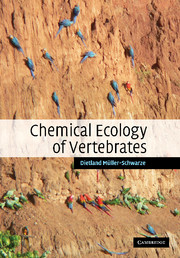Book contents
- Frontmatter
- Contents
- Preface
- Acknowledgements
- 1 The odorsphere: the environment for transmission of chemical signals
- 2 Properties of vertebrate semiochemicals
- 3 Odor production and release
- 4 Chemical cues in orientation and navigation
- 5 Chemoreception
- 6 Signaling pheromones I: discrimination and recognition
- 7 Signaling pheromones II: sex and alarm pheromones and evolutionary considerations
- 8 Intraspecific signals: priming pheromones
- 9 Development of intra- and interspecific chemical communication
- 10 Allomones I: chemical defense by animals
- 11 Allomones II: plant chemical defenses against herbivores
- 12 Kairomones and synomones
- 13 Practical applications of semiochemicals
- Glosssary
- References
- Index
Preface
Published online by Cambridge University Press: 23 November 2009
- Frontmatter
- Contents
- Preface
- Acknowledgements
- 1 The odorsphere: the environment for transmission of chemical signals
- 2 Properties of vertebrate semiochemicals
- 3 Odor production and release
- 4 Chemical cues in orientation and navigation
- 5 Chemoreception
- 6 Signaling pheromones I: discrimination and recognition
- 7 Signaling pheromones II: sex and alarm pheromones and evolutionary considerations
- 8 Intraspecific signals: priming pheromones
- 9 Development of intra- and interspecific chemical communication
- 10 Allomones I: chemical defense by animals
- 11 Allomones II: plant chemical defenses against herbivores
- 12 Kairomones and synomones
- 13 Practical applications of semiochemicals
- Glosssary
- References
- Index
Summary
Chemical ecology is developing by leaps and bounds. Thousands of growing points involve all organisms and offer ample opportunities for collaboration of chemists and biologists. The biological aspect draws on diverse fields, ranging from molecular genetics, anatomy, histology, and genetics to endocrinology, animal behavior, and systems ecology. Given this confluence of many strands of science, it is little wonder that there is not a textbook for chemical ecology courses.
While plant and insect studies dominate chemical ecology, the percentage of papers on vertebrates in the Journal of Chemical Ecology has held steady at 10–19% since its inception in 1975. Most papers on vertebrates deal with mammals, and birds have only recently attracted the attention of chemical ecologists (Müller- Schwarze, 2005). Chemical ecology is both a basic and an applied science. Fundamental questions include reproductive interactions in fish, olfactory imprinting, chemistry and functions of scent marking in mammals, olfactory foraging in seabirds, self-medication in animals, and protein chemistry. Practical applications consider, for example, challenges in fish migration, sea turtle conservation, pest control, and animal husbandry. To succeed in solving practical problems, we first have to establish the basic natural history, behavior, and ecology of a species: To lure brown tree snakes to scented traps, we need first to know what food odors or pheromones these animals attend to. In contrast to insects, much behavior of mammals is under multisensory control, and applications of repellents and attractants based on natural behavior are yet to be realized. Attractants are still in the art stage, much the same way as hunters and trappers have always used them.
- Type
- Chapter
- Information
- Chemical Ecology of Vertebrates , pp. ix - xiPublisher: Cambridge University PressPrint publication year: 2006



